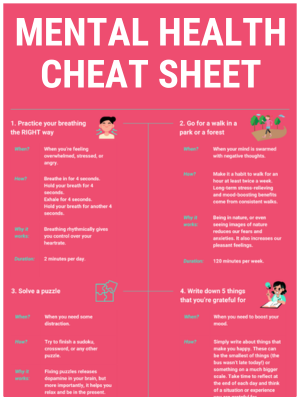Have you ever driven to a place you have been to many times and arrived without even realizing it? In life we are often in ‘autopilot’ mode, meaning we go through the motions but are not living in the present moment.
When we are distressed, we are usually in ‘autopilot’ mode. We are not aware of what is happening in the present moment, but automatically stress over past events, or predict future events. Being present in the moment helps you to interrupt the automatic thoughts that come when you are in autopilot mode. Bringing our focus to the present may help with reducing distressing moods and thoughts.
This article will explore what it means to be present, why it is so integral to our well-being, and provide some tips that you can integrate into your life to focus on the present.
Contents
What does it mean to be present?
Being present in the moment means enhancing your awareness of what is happening right now, and letting it happen without judgment. When we think of staying present, we often think of mindfulness, which is the state of being conscious or aware of something.
Mindfulness and meditation expert James Baraz says being present means the following:
Being present is simply being aware of what is happening right now without wishing it were different; enjoying the present without holding on when it changes (which it will); being with the unpleasant without fearing it will always be this way (which it won’t).
James Baraz
When we are in the present moment, we are fully aware of the current situation without letting internal thoughts take us to another place. This does not mean that we must be present all the time. In fact, being present all the time is not realistic and would be quite difficult.
However, it does mean that we can enhance our ability to remain present, and this can be particularly useful during moments of distress.
Why is being present so important?
Staying in the present moment can play a significant role in staying happy and healthy. Studies show that being present can help with symptoms of anxiety and depression.
A meta-analytic review of the effects of mindfulness-based therapy on depression and anxiety shows that mindfulness-based therapy is an effective intervention for treating anxiety and mood issues.
The authors highlight:
Experiencing the present moment nonjudgmentally and openly can effectively counter the effects of stressors because excessive orientation toward the past or future when dealing with stressors can be related to feelings of depression and anxiety.
Another study showed similar findings, illustrating that being present in the moment helps to reduce worrying, rumination, and mood issues.
Sometimes when we are in autopilot mode, certain negative thinking patterns can become a habit, and it becomes easier to get trapped in such patterns of thinking. By becoming more aware of our feelings, body sensations, and thoughts in the present moment, we can avoid falling into automatic patterns of thinking that may worsen our mood.
Being present is integral to our well-being as it can help us to cope with difficult life events and daily stressors. A 2016 study found that present-moment awareness is associated with enhanced responses to daily stress and stressful events in the future. Additionally, a study from 2020 explored the benefits of meditation and mindfulness during times of crisis such as COVID-19. The authors demonstrate that meditation and mindfulness techniques can offer a helpful way to cope with change, uncertainty, and crisis.
The pandemic has changed so much of our daily lives and caused additional fear, anxiety, and depression among the general population. With so many circumstances beyond our control, practicing being in the present moment without fear of the future or ruminations about the past can help us to cope with difficult circumstances beyond our control.
💡 By the way: Do you find it hard to be happy and in control of your life? It may not be your fault. To help you feel better, we’ve condensed the information of 100’s of articles into a 10-step mental health cheat sheet to help you be more in control. 👇
What are some ways to be more present?
Being present at the moment takes time and practice. Below are four things we can do to increase the present moments in our lives.
1. Try a mindfulness meditation
Mindfulness meditation involves paying attention to your thoughts and sensations without judgment. There are several types of mindfulness meditations you can try, both on your own or guided by an instructor.
An example of a mindfulness meditation exercise you can do alone is a ‘five senses scan’. Pay attention to your senses; sight, sound, smell, taste, and touch. Notice what you see around you, what it tastes and smells like (even if it smells/ tastes like nothing), notice the sensation of touch in your environment and the noises you hear. If there are thoughts interrupting this exercise do not judge or fight them.
Allow them to happen and then let them pass through. This exercise brings you to the present moment and may help to calm your mind.
If you prefer a guided mindfulness meditation there are many resources online, including this 10-minute meditation. Mindfulness meditation can take patience and time to master, so try and integrate this practice into your life as much as possible. You can start with once a week, and gradually work your way up to daily practice.
In today’s day and age, our lives heavily rely on or involve social media. You may receive constant notifications throughout the day, making it difficult to live in the present moment. It’s also one of the primary reasons we compare ourselves to others (which is not a good idea).
Avoiding social media altogether can be difficult, and not possible for some. However, limiting social media time, even if it is just taking a short 10-minute break can help you to stay in the present moment, and reconnect with the here and now.
3. Enjoy the present moment
We spend so much time looking forward to something that may happen in the future or worrying about things that have happened in the past. It is easier for us to stress over unpleasant events than to appreciate the good things that happen.
Enjoying the present moment can be as simple as appreciating the feeling of the sun on your skin, getting coffee with a close friend, or even a stranger smiling at you. When you pay attention to pleasant events happening at the moment it can help to balance our emotions and let go of distractions such as negative thoughts and feelings.
4. Interrupt rumination cycles as they happen
Rumination involves repetitively focusing on feelings of distress or negative thoughts. When we are ruminating, we are often fixating on problems, emotions, or experiences, without taking action to address the issue at hand. Interrupting rumination cycles as they happen can help us to stay present and reconnect with what is happening in the here and now. Here’s an article that specifically helps you deal with rumination.
It does not mean that the issue will be resolved and that our negative emotions will magically disappear. However, it does allow us to take a step back from the cycle of rumination and calm the negative emotions. When you feel a sense of calmness or relaxation it is easier to address the situation that led to the rumination in the first place.
If you are interested in learning some helpful tips to stop ruminating, check out this article!
5. Engage in creative activities
Finding a sanctuary in creative activities can be a refreshing way to anchor ourselves in the present. Whether it’s painting a canvas with vibrant hues, crafting a piece of pottery, or penning down a poem, immersing oneself in a creative endeavor can be a gateway to experiencing the richness of the moment.
It’s not about creating a masterpiece, but about enjoying the process, feeling the materials in your hands, and expressing yourself freely.
The key is to be fully engaged in the activity, letting your senses soak in the experience without judgment. If thoughts about the past or future start to creep in, gently bring your focus back to the task at hand. Over time, you might find that these creative sessions become a cherished oasis of presence and joy in your routine.
6. Outdoor activities and nature walks
Nature has a magical way of grounding us in the present moment. The simple act of stepping outside and immersing ourselves in the natural world can be a potent antidote to the stresses of modern life.
The rustle of leaves, the fragrance of blooming flowers, and the sight of fluttering butterflies can be simple yet profound reminders to slow down and savor the present.
To make the most of this, plan regular outings where you can be in close contact with nature. Leave your gadgets at home or switch them off to avoid distractions. As you walk, make a conscious effort to notice the details around you – the texture of bark, the pattern of leaves, the songs of birds. You might even carry a journal to jot down your observations or sketch the scenes you encounter.
This practice not only fosters a deeper connection with the present moment but also nurtures a sense of wonder and appreciation for the natural world.
💡 By the way: If you want to start feeling better and more productive, I’ve condensed the information of 100’s of our articles into a 10-step mental health cheat sheet here. 👇
This Cheat Sheet Will Help You Be Happier and More Productive
Thrive under stress and crush your goals with these 10 unique tips for your mental health.
Wrapping up
Learning to live in the moment requires us to slow down and appreciate the here and now. It can take time, patience, and energy, but in the end, the benefits you can experience by being present are worth the effort. Start small; try one of the tips in this article, and then work your way up to establishing a daily routine that incorporates strategies to increase your ability to stay present.
What’s your take on trying to be more present in life? Do you find it hard to enjoy the present without worrying about anything else? I’d love to hear from you in the comments below!



